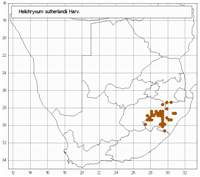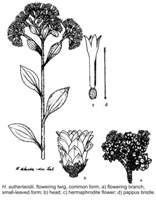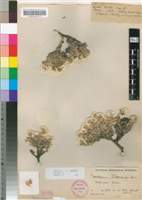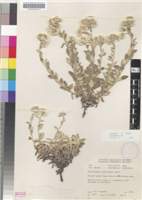Common names:
Mollepelle, senkontoana, ntlo-ea-mokhobane. (SS)
Origin of name:
After Peter Cormac Sutherland (1822-1900), medical doctor, became government geologists then Surveyor General of KwaZulu-Natal; corresponded with William Hooker at Kew and sent parcels of plants and seeds.
Diagnostic characters:
Cream bractsMedium-sized flowersBranched inflorescenceLeaves bicoloured
Description:
Well-branched shrub up to 400 mm tall, commonly lax, sometimes compact, vegetative twigs closely leafy, flowering twigs more distantly so. Leaves up to c. 25 x 12 mm, rhomboid or elliptic, abruptly narrowed to a flat, petiole-like, clasping base up to c. 12 mm long, apex more or less acute, upper surface thinly grey-woolly, lightly cobwebby or sometimes glabrous, lower surface white-felted, triplinerved, nerves nearly always prominent below. Heads homogamous, narrowly campanulate, 4�5 mm long, 5�7 mm across the radiating bracts, few to many in corymbose panicles c. 20�120 mm across. Involucral bracts in c. 6 series, graded, imbricate, outer pale brownish, webbed together with wool, inner much exceeding flowers, tips milk-white, opaque. Receptacle honeycombed. Flowers 9�25, yellow. Achenes 1�1.25 mm long, barrel-shaped, with myxogenic duplex hairs. Pappus bristles many, equaling corolla, scabrid, bases not cohering.
Flowering begins in mid-February, is at its peak in April, and is fading by July.
Distribution:
It is particularly common in the Drakensberg, where it grows in clumps hanging from crevices in cliff faces and rock outcrops. Ranges from the Barberton Mountains in Mpumalanga to the low Drakensberg on the Mpumalanga-KwaZulu-Natal border, the NE. mountainous corner of the Free State, Lesotho, the KwaZulu-Natal Drakensberg and its outliers, and the more elevated parts of the KwaZulu-Natal Midlands.
Grassland Biome.
Notes:
The commonest form of H. sutherlandii is a lax rounded shrublet with the flowering stems standing well away from the body of the plant. A compact, small-leaved form with very short flowering twigs occurs in parts of the Drakensberg, mainly above c. 2 600 m, and may be difficult to distinguish from small-headed plants of H. confertum (below), which may grow with H. sutherlandii, but generally flowers earlier, in spring and late winter. It is possible that there is some crossing between the species, but field and laboratory studies are needed to confirm this.
Taxonomy:
Literature:
Helichrysum sutherlandii Harv. in F.C. 3: 218 (1865); Moeser in Bot. Jb. 44: 306 (1910), excl. H. confertum N.E. Br.; Hilliard, Compositae in Natal 212 (1977).
Type:
Lectotype: [Lesotho] Basutoland, Mequatlong, Cooper 709 (TCD; E; K; Z, isolecto.).
Synonym(s):
Gnaphalium pulviniforme O. Kuntze, Rev. Gen. 3: 153 (1898). Helichrysum pulvinatum [O. Hofftn. ex] O. Kuntze, Rev. Gen. 3: 153 (1898) in syn. Type: KwaZulu-Natal, Van Reenen's Pass, 1 900 m, Kuntze s.n. (Z, holo.; K, iso.).
H. sutherlandii var. semiglabrum N.E. Br. in Kew Bull. 1906: 21 (1906). Type: KwaZulu-Natal, near Van Reenen's Pass, 5000�6000 ft, Wood 5702 (K, holo.; NH, iso.).
Vouchers:
Hilliard 4994 (E; K; M; MO; NU; PRE; S) and 5010 (E; K; NU; PRE), both similar to the lectotype; Wright 761 (E; K; MO; NU; S), Esterhuysen 8842 (BOL), both the common lax plant.


_sml.jpg)
_sml.jpg)
_sml.jpg)
_sml.jpg)

